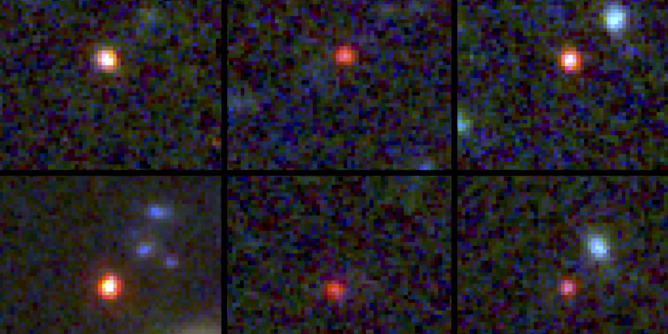Uh, James Webb Found Some Galaxies That Technically Shouldn't Exist

"Hearst Magazines and Yahoo may earn commission or revenue on some items through these links."
The James Webb Space Telescope (JWST) has spotted six galactic candidates that shouldn’t exist.
The galaxies formed about 500-700 million years after the Big Bang, and are thought to each be about the size of the Milky Way.
If these galaxies are confirmed, their discovery will challenge almost every model we have of our ancient universe.
The James Webb Space Telescope (JWST) continues to show us that the universe’s definition of “impossible” isn’t quite as rigid as we might think.
A team of international researchers recently discovered six galaxies in the telescope’s first data set—galaxies from the very early universe that, simply put, shouldn’t exist. They’re thought to have formed incredibly early in the cosmological timeline, only about 500-700 million years after the Big Bang.
It’s not that galaxies weren’t forming back then, because they were. But they weren’t like this. The ones spotted in this study are, as far previous research and models have told us, too red to be as bright as they are, and too bright to be as red as they are.
Their bold color is what marks these galaxies as so old. As the universe expands and objects fly farther away from us faster and faster, the light they produce gets more and more stretched out. And the more stretched out light gets, the redder it looks. Objects moving towards us, on the other hand, look blue because their motion compresses light rather than stretching it out.
This elongating of light is called redshift, and it’s one of the ways astronomers date things in the universe. Things that are incredibly old, like these galaxies, have a very high redshift and appear bright red in observational data.
But not only are these galaxies red—their brightness indicates that they’re big. Way bigger than they should be. Calculations done by the research team suggest that these six galactic candidates are each about the size of our own Milky Way.
And according to almost all of our best models, there just shouldn’t have been enough stuff present in the universe that early to form these things. The objects are so “impossible” in fact that, according to a statement, the team has been informally referring to them as “universe breakers.”
Now, there’s a chance that these detections are false alarms. It’s only the first data set from JWST, and because the telescope wasn’t specifically trying to collect information on these objects, some of it is missing. They could turn out to be something else entirely when we take a second look, such as faint quasars—a type of active galactic nucleus where dust and debris falls into a black hole in such a way that it produces vast amounts of electromagnetic radiation.
But if follow-up observations confirm that these objects are in fact massive galaxies from near the beginning of the universe, we have a lot of rewriting to do. These galaxies being real would disagree with about 99 percent of our current models of the early universe, demanding some serious re-investigation into a matter many research thought was pretty much settled.
“What’s funny is we have all these things we hope to learn from James Webb and this was nowhere near the top of the list,” Joel Leja, one of the authors of the study, said in a press release. “We’ve found something we never thought to ask the universe.”
You Might Also Like

